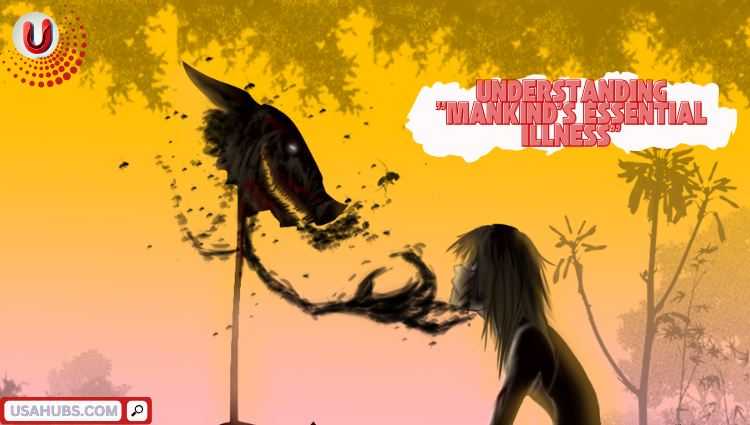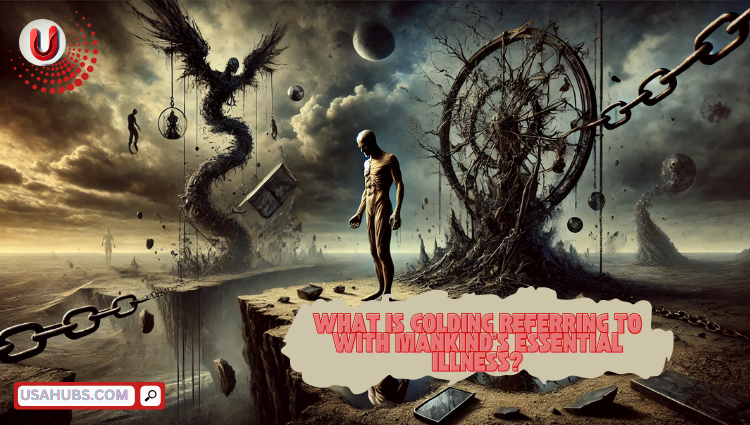In his novel Lord of the Flies, William Golding explores the complex and often dark nature of human behavior, which reflects his view of mankind’s essential illness. This concept refers to the inherent flaws and destructive tendencies embedded in human nature, something that ultimately leads to chaos and moral decay in societies. Through his characters and the experiences they endure on a deserted island, Golding paints a grim portrait of humanity’s capacity for violence, selfishness, and moral disintegration when removed from the constraints of civilization. In this article, we will explore Golding’s concept of mankind’s “essential illness,” breaking down what it represents, how it manifests in the novel, and its broader implications for society.
Understanding “Mankind’s Essential Illness”

Golding’s term “essential illness” is not referring to a physical disease but rather a metaphorical sickness in human nature. It suggests that there is something fundamentally flawed in human beings, something that causes people to act irrationally, destructively, and even inhumanely under certain circumstances. This idea suggests that beneath the surface of civility and societal norms, there is an inherent darkness in human beings that can emerge in the absence of rules, structure, and authority.
Golding’s exploration of this idea is influenced by his own experiences during World War II, where he witnessed firsthand the depths of human cruelty and violence. The “essential illness” is not just a critique of individual moral failings but a broader commentary on humanity’s collective capacity for evil. In Lord of the Flies, Golding examines the struggle between civilization and savagery and suggests that when the structures of society break down, mankind’s fundamental flaws can rise to the surface.
Also Check: What is Felonious Assault? A Comprehensive Guide
The Island as a Microcosm of Society
In Lord of the Flies, a group of boys is stranded on a deserted island with no adults to govern them. Initially, the boys attempt to form a society based on the rules and values they were taught in the outside world. They elect a leader, Ralph, who strives to maintain order and civility. However, as time passes, the boys begin to succumb to their primal instincts, and their society disintegrates into chaos. This breakdown serves as a powerful metaphor for the fragility of civilization and the ease with which humans can revert to barbarism.
The island itself acts as a microcosm of society, where the boys’ interactions and behavior reflect broader human tendencies. The absence of adult supervision removes the external forces that typically keep human behavior in check, revealing the darker impulses that lie beneath the surface. This environment allows Golding to explore the inherent “illness” within mankind and how quickly it can surface when the veneer of civilization is stripped away.
The Characters and Their Roles
Golding uses the novel’s characters to represent different aspects of human nature and the struggle between civilization and savagery. Ralph, who represents order, leadership, and rationality, is ultimately powerless to stop the descent into violence and chaos. Jack, on the other hand, represents the pull of primal instincts and the temptation to embrace power and control through violence. As Jack gains influence over the boys, he leads them away from civilization, and their actions become more savage.
Piggy, the intellectual and rational boy, embodies reason and logic, but he is unable to protect himself from the cruelty of the other boys. His physical weakness and intellectual strength contrast with the violence and emotional intensity of the others. Simon, the more spiritual and empathetic character, symbolizes the goodness that can exist in humanity, but his fate demonstrates the dangers of idealism in a world governed by selfishness and brutality.
Each of these characters contributes to the portrayal of mankind’s “essential illness” in different ways, highlighting how human nature is multifaceted and complex. While some characters try to maintain moral principles, they are overpowered by the destructive forces of others. This demonstrates Golding’s belief that mankind’s fundamental flaws, such as greed, jealousy, and the thirst for power, are always lurking beneath the surface and can easily overpower the more noble aspects of human nature.
The Role of Fear and the “Beast”
One of the central themes of Lord of the Flies is the concept of fear and how it drives the boys to violence and irrational behavior. The boys become terrified of a mythical “beast” that they believe inhabits the island. This fear of the unknown becomes a powerful motivator, driving them to commit acts of violence in an attempt to protect themselves from an imagined threat.
The “beast” symbolizes mankind’s own internal darkness, the irrational fear that can lead to destructive behavior. It represents the fear of the unknown, but also the fear of the darker impulses within ourselves. Golding suggests that when people are driven by fear, they become more susceptible to the very “illness” he describes. The fear of the beast leads the boys to abandon reason and embrace superstition and violence, highlighting how fear can exacerbate mankind’s flaws and cause people to act in ways that contradict their better judgment.
The Death of Innocence
As the novel progresses, the boys become more savage, and the violence escalates. The murder of Simon, an innocent character who symbolizes purity and goodness, marks the point of no return. Simon’s death, a brutal act committed by the boys in a frenzied moment of hysteria, illustrates the complete collapse of civilization and the triumph of mankind’s “essential illness.” It is a moment of profound darkness, where the boys abandon all moral considerations and give in to their primal instincts.
Simon’s death is a powerful metaphor for the loss of innocence and the inevitability of corruption in the face of mankind’s inherent flaws. It suggests that no matter how much society tries to instill values of goodness and civility, there is an underlying darkness within all humans that can emerge when the structures of society break down.
Implications for Society

Golding’s depiction of mankind’s essential illness is not just a commentary on the boys in Lord of the Flies, but a broader reflection on human society as a whole. Golding suggests that all human beings are susceptible to the same flaws and impulses that the boys exhibit. In the right circumstances, people can easily fall into violence, selfishness, and chaos, especially when they feel threatened or when the rules of society are no longer in place.
This idea has significant implications for the way we view human nature and the structure of societies. It suggests that while civilization may seem to be a veneer that keeps our darker impulses in check, underneath, there is always the potential for cruelty and violence. Golding’s work challenges the idea that humans are inherently good, instead presenting a more pessimistic view of humanity’s potential for evil.
Also Check: Is the Pride Go-Go Elite Traveler Approved for Airplane Use?
FAQs
What is Golding’s concept of mankind’s “essential illness” in Lord of the Flies?
Golding’s concept of mankind’s “essential illness” refers to the inherent flaws and darker impulses within human nature. It is a metaphorical “sickness” that causes people to act destructively, selfishly, and violently, especially when societal structures are removed. In Lord of the Flies, this illness is revealed through the boys’ descent into savagery on the deserted island, showing that without the constraints of civilization, humanity’s primal instincts emerge.
How does the island in Lord of the Flies represent society?
The island in Lord of the Flies acts as a microcosm of society, where the boys’ behavior reflects broader human tendencies. Initially, they attempt to form a structured society with rules and leaders, mirroring the order of the outside world. However, as their society disintegrates into chaos, the novel highlights how quickly human nature can revert to savagery when the structures that keep destructive behaviors in check are removed. The island becomes a testing ground for the inherent darkness in human nature.
What role does fear play in Lord of the Flies and how does it relate to mankind’s essential illness?
Fear plays a central role in Lord of the Flies, particularly through the boys’ belief in a mythical “beast” on the island. This fear of an imagined threat drives the boys to irrational and violent behavior, revealing the destructive power of fear. Fear amplifies mankind’s “essential illness,” as it encourages the boys to abandon reason and embrace superstition and violence. It shows how fear can exacerbate humanity’s darker impulses and lead to chaos and destruction.
Conclusion
In Lord of the Flies, William Golding explores the concept of mankind’s essential illness, the inherent flaws and destructive tendencies that reside within all human beings. Through the story of a group of boys stranded on an island, Golding shows how quickly civilization can break down and how easily people can revert to savagery when removed from societal norms. By examining the characters, the theme of fear, and the loss of innocence, Golding provides a powerful commentary on the dark side of human nature and the fragility of civilization.

